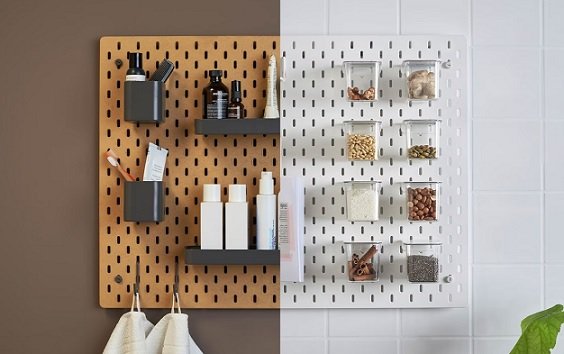In the world of organization and creative expression, pegboards stand out as versatile and practical solutions that have transcended their humble origins. Originally designed for tool storage, pegboards have evolved into dynamic organizational systems used in homes, offices, and even artistic spaces. In this article, we’ll explore the multifaceted nature of pegboards, examining their history, practical applications, and the creative possibilities they offer.
A Brief History of Pegboards
The concept of using pegs and boards for storage dates back centuries, with evidence of similar systems found in ancient civilizations. However, the modern pegboard, as we know it, gained popularity in the mid-20th century.
In the 1960s, the famous entrepreneur and home improvement expert, Louise D. Dowe, patented the “Peg-Board Storage Apparatus.” This invention revolutionized the way tools and small items were stored in workshops and garages. Pegboards quickly became a staple in the DIY community, providing an efficient and space-saving solution for organizing tools.
Practical Applications in Organization
Workshop and Garage Organization:
The original intent of pegboards was to serve as efficient storage solutions in workshops and garages. By utilizing hooks, pegs, and various accessories, individuals could organize and display tools in a way that not only maximized space but also made items easily accessible. This organization method is still widely used today in both professional and hobbyist settings.
Kitchen and Pantry Storage:
Pegboards have found their way into kitchens and pantries, offering a customizable and visually appealing storage solution. By hanging pots, pans, utensils, and even shelves, homeowners can optimize their kitchen space and keep essentials within reach. This application not only adds functionality but also serves as a stylish design element.
Home Office and Craft Rooms:
In-home offices and craft rooms, pegboards serve as innovative organizational tools. They can be customized with baskets, shelves, and hooks to accommodate various supplies such as stationery, craft materials, and office essentials. This adaptability allows users to create a personalized and efficient workspace.
Retail Displays:
Pegboards have made their mark in the retail industry as well. Stores use pegboard displays to showcase products, especially those with hanging packaging. The flexibility of rearranging displays makes it easy for retailers to refresh their setups and highlight different merchandise.
Creativity Unleashed: Pegboards in Art and Design
Art Studios and Workshops:
Pegboards have become integral in art studios and workshops, providing artists with a versatile and customizable solution for organizing their tools. Paintbrushes, scissors, and other art supplies can be hung on pegboards for easy access, turning the workspace into an organized and visually inspiring environment.
DIY and Craft Projects:
The flexibility of pegboards makes them a popular choice for DIY enthusiasts and crafters. From jewelry organizers to wall decor, pegboards serve as a blank canvas for creative projects. Users can paint, decorate, and add various accessories to customize pegboards to match their style and preferences.
Kids’ Rooms and Play Areas:
Pegboards have found a playful application in children’s rooms and play areas. By incorporating colorful pegboards with hooks, shelves, and containers, parents can create an interactive and organized space for toys, art supplies, and other items. This not only encourages tidiness but also sparks creativity in young minds.
Choosing and Installing Pegboards: Tips for Success
Material and Durability:
When selecting pegboards, consider the material. Common options include hardboard, metal, and plastic. Choose a material that aligns with your intended use and offers the durability required for the items you plan to hang.
Size and Layout:
Assess the available space and plan the layout of the pegboard accordingly. Consider the items you want to store or display and ensure there is ample space between pegs to accommodate various accessories.
Accessories and Hooks:
Pegboards are only as good as the accessories they come with. Invest in a variety of hooks, shelves, and containers to enhance the functionality of your pegboard. Different accessories cater to specific items, ensuring a well-organized and visually appealing display.
Installation:
Installing a pegboard is a relatively straightforward process, but it requires careful consideration. Ensure that the pegboard is securely mounted to the wall, using appropriate anchors or screws. Pay attention to weight limits to prevent overloading and potential damage.
Pegboards in the Digital Age: Virtual Organization
As technology continues to advance, the concept of pegboards has also found a place in the digital realm. Virtual pegboard apps and online platforms allow users to organize and plan various aspects of their lives, from project management to personal goals. These digital pegboards provide a visual and interactive way to stay organized in an increasingly tech-centric world.
Conclusion: Pegboards as Dynamic Organizational Tools
From the workshop to the kitchen, from art studios to children’s play areas, pegboards have proven themselves as dynamic organizational tools with broad applications. Their evolution from a simple storage solution to a creative canvas for personal expression showcases the adaptability and enduring appeal of this versatile concept.
As individuals continue to seek innovative ways to enhance organization and unleash creativity in their spaces, pegboards stand ready to meet these needs. Whether hanging tools in a garage or displaying art supplies in a studio, pegboards offer a customizable and practical solution that transcends the boundaries of traditional storage methods.





